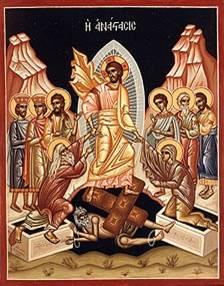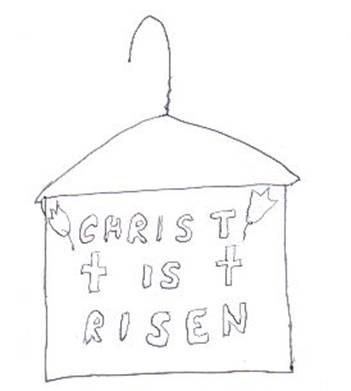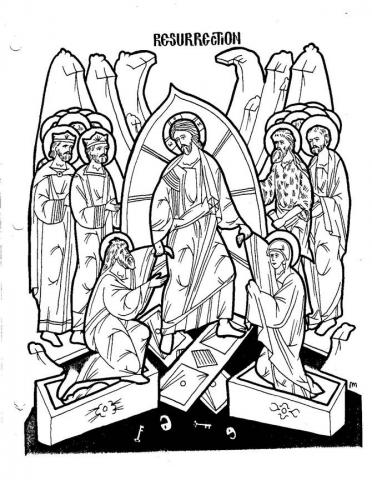Pascha
PASCHA
 Objectives:
Objectives:
- Students should understand the icon, its characters and its significance.
- Students should know the Troparion of the feast and “Christ is risen…”
- Students should know the Paschal greeting and response, preferably in several languages.
Possible Lesson Plan:
- Open with prayer.
2. The icon: again begin with its review and discussion. Christ is the central figure, robed in white (Why?) surrounded by light (Why?), at His feet are the brass gates of Hades, the keys, and the locks that He destroyed. Adam is being pulled from his tomb by Christ with His right hand and Eve with His left. The righteous from the Old Testament gather on the left; the 2 in the front are Kings David and Solomon. The righteous from the New Testament are those on the right, those who died after the Incarnation and before the resurrection; in front we find St. John the Baptist and St. Joseph. See if the students remember the stories of each of these characters.
- Scripture references: Matthew 28, Mark 16, Luke 24, John 20. Again divide into 4 groups, each reporting on its gospel to the class.
- Service References: Sing them!
Troparion: Thy resurrection, O Christ our Savior, the angel in heaven sing, enable us on earth to glorify thee in purity of heart.
Another Troparion: Christ is risen from the dead, trampling down death by death, and upon those in the tombs bestowing life!
Megalynarion: The angel cried to the Lady full of grace, Rejoice, O pure Virgin. Again I say: Rejoice. Your Son is risen from his three days in the tomb. With himself he has raised all the dead. Rejoice, all ye people. Shine! Shine! O new Jerusalem! The glory of the Lord has shone on you. Exult now and be glad, O Zion! Be radiant, O pure Theotokos, in the resurrection of your Son.
How do we celebrate Pascha? Resurrection! The Church is in darkness. Light spreads to all from the Trikirion, the 3 in 1 candle representing the Trinity. We process around the church like the myrrh-bearing women walking to the tomb. Eggs represent new life. We greet each other with:
English: Christ is risen! Indeed He is risen!
Greek: Christos anesti! Alethos anesti!
Russian: Christos voskrese! Voistinu voskrese!
Arabic: Al-masi-kam! Haq an qaam!
Romanian: Christos inviat! Adeverat inviat!
6. Discussion questions:
Why is the resurrection considered the central truth of Christianity? Was the resurrection a hoax perpetrated by the disciples? (Would each of them later die for what they knew to be a lie?) Or did the authorities move the body? (But why didn’t they then display it to the public when the disciples claimed He had risen and thus prove He was still dead?) Or did Jesus never actually die at all, but just faint? (All contemporary accounts, even those of the Jewish and Roman authorities of the time, agree that He most certainly died.) Did the apostles all have identical “hallucinations” after His death of His appearances?
7. Play a learning game: Holy Week Cards. Pass out cards with the major events of Holy Week, about 4 per person. The class must assemble these cards in chronologic order, producing a time line from Palm Sunday to Pascha.
- Make Easter Banners. Take a piece of felt and staple over a coat hanger. Cut out letters to spell “Christ is Risen.” Let the children cut out other decorations – crosses, flowers, eggs, etc. – or bring in silk flowers or lilies. Glue these onto the banner.
- Close again with the song and a prayer.

